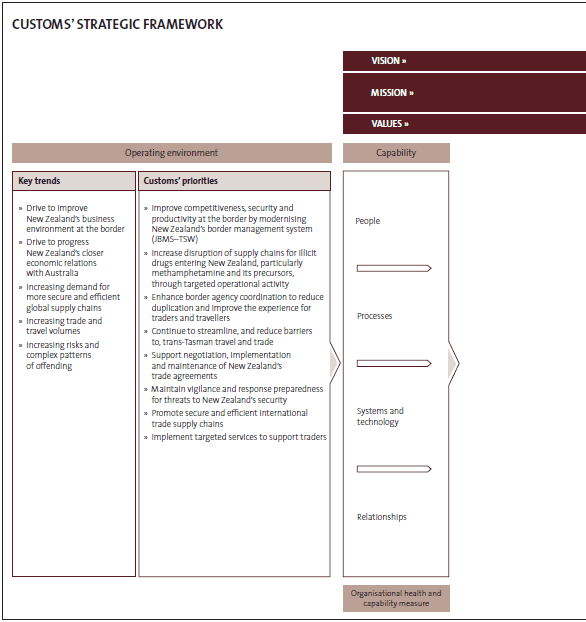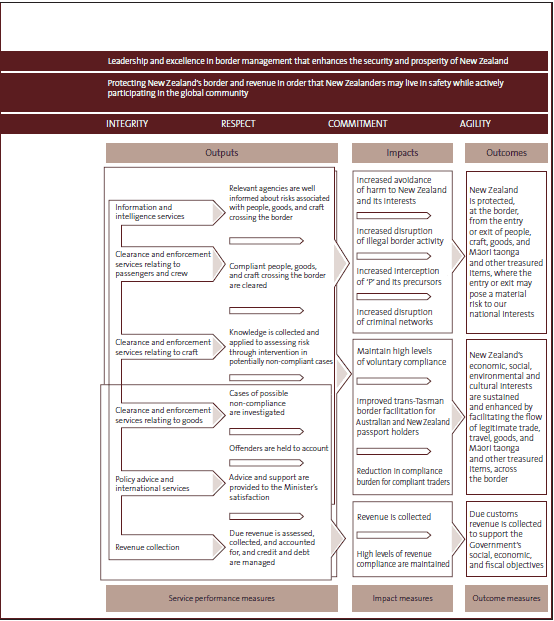Part 6: New Zealand Customs Service
Background
6.1
The responsibilities of Customs involve protecting the country from major threats and risk. It aims to achieve this while facilitating the legitimate movement of people, goods, and craft across the border with minimal disruption. Customs is also responsible for collecting and protecting more than 15% of the Crown's revenue base in the form of import duty, excise duty, and goods and services tax collected at the border.
Strategic context
6.2
The first three sections of Customs' SOI provided a comprehensive and understandable summary of its purpose, the context within which it operates, the challenges that it faces, the outcomes that it was seeking to achieve, and its priorities (see Figure 18).
Figure 18
The nature and scope of the New Zealand Customs Service's functions
| Our services We provide:
|
Source: New Zealand Customs Service (2010), Statement of Intent 2010-2013, Wellington, page 6.
The strategic direction section of the SOI clearly highlighted that Customs needed to work with several other partners to achieve success (see Figure 19).
Figure 19
The New Zealand Customs Service's need to work with other agencies
| Other agencies Customs works with other agencies on a variety of objectives, which includes support for New Zealand's expanding programme of trade agreements and capacity building support for some Pacific countries, with the Ministry of Foreign Affairs and Trade (MFAT). Our work with the defence forces seeks to maintain vigilance and respond to increasing security risks to New Zealand. We also prepare to respond to threats from pandemics with the Ministry of Health. We work with the New Zealand Police to contribute to the whole-of-government response To illicit drugs; and the Department of Conversation and Ministry of Agriculture and Forestry to disrupt smuggling of endangered species. |
Source: New Zealand Customs Service (2010), Statement of Intent 2010-2013, Wellington, page 9.
6.3
The priorities for Customs for the period of the SOI were also clearly set out within the context of the Government's overall priorities.
6.4
The SOI highlighted that Customs would specifically contribute to the Government's goals to "grow the economy; step up infrastructure; pursue trade liberalisation and trade agreements; reduce regulatory and compliance demands; make communities safe; clamp down on criminal gangs and the ‘P' trade; and reduce violent crime" through its focus on a number of priorities (see Figure 20).
Figure 20
How the New Zealand Customs Service intended to contribute to the Government's goals
| Customs' priorities From 2010/11, Customs will contribute to the Government's goals through a focus on our outcomes, and three priorities, as agreed with the Prime Minister and Minister of Customs:
Over the next three years, Customs will continue to advance other key aspects of its work programme to:
|
Source: New Zealand Customs Service (2010), Statement of Intent 2010-2013, Wellington, pages 7-8.
6.5
The section of the SOI on the operating environment clearly highlighted the key trends and priorities that Customs needs to respond to. These were then usefully linked to key risks and the mitigating actions that Customs could take. Customs presented all this information together in its strategic framework (see Figure 21).
Figure 21
Strategic framework for the New Zealand Customs Service


Source: New Zealand Customs Service (2010), Statement of Intent 2010-2013, Wellington, pages 10-11.
Specifying and presenting the outcomes framework
6.6
The three outcomes that Customs contributes to were clearly set out on page seven of the SOI. The SOI referred to the Border Sector joint outcomes of "Protection and Facilitation" before it mentioned the outcomes specific to Customs (see Figure 22).
Figure 22
Three outcomes that the New Zealand Customs Service contributes to
| Customs' outcomes Customs contributes to three overarching outcomes: Protection: New Zealand is protected, at the border, from the entry, or exit, of people, goods, craft, and Māori taonga and other treasured items, where the entry or exit may pose a material risk to our national interests Facilitation: New Zealand's economic, social, environmental, and cultural interests are sustained and enhanced by facilitating the flow of legitimate trade, travel, goods, and Māori taonga and other treasured items, across the border Revenue: Due customs revenue is collected to support the Government's social, economic, and fiscal objectives. |
Source: New Zealand Customs Service (2010), Statement of Intent 2010-2013, Wellington, page 7.
6.7
The strategic framework provided a clear overview of Custom's intervention logic, linking output (classes) to impacts and ultimately outcomes. Including information on the operating environment and dimensions of capability in the strategic framework also helped the reader to understand the business as a whole.
6.8
Sections on each of the outcomes clearly explained to the reader:
- what Customs was seeking to achieve;
- why the outcome was important;
- what Customs would do to achieve the outcome, including reference to the priorities referred to earlier in the document; and
- how Customs would demonstrate success.
Main measures and targets for outcomes and impacts
6.9
For each of its three outcomes, Customs clearly identified the indicators and measures that it would use to show progress at the impact level (see Figure 23).
Figure 23
How the New Zealand Customs Service has identified impacts, indicators, and measures for its facilitation outcome

Source: New Zealand Customs Service (2010), Statement of Intent 2010-2013, Wellington, page 21.
Linking outcomes to impacts to outputs
6.10
Customs' SOI referred to it being funded through Vote Customs. It included its six output classes in it strategic framework diagram, as well as mentioning that it delivers its services relevant to each outcome through a number of output classes.
Specifying outputs and output classes
6.11
Customs has six output classes (compared to 10 output classes in the 2009-12 SOI) that match to its appropriations in Vote Customs. These are: information and intelligence services; clearance and enforcement services relating to passengers and crew; clearance and enforcement services relating to craft; clearance and enforcement services relating to goods, policy advice and international services; and revenue collection.
6.12
The rationale for the new output class structure was that it would:
- improve Customs' ability to respond to changes in workload; and
- provide a more meaningful aggregation of outputs that better reflects Customs' performance story.
6.13
The change in output classes between years was articulated in the Information Supporting the Estimates, which made clear that there are no material changes to the outputs delivered.
Performance measures and targets for outputs
6.14
Overall, the relevant outputs with associated measures were identified in the 2010/11 Information Supporting the Estimates. Targets were included, along with useful contextual information about the demand for Customs' services – for example, - the volume of passengers, mail, and vessels expected in the year (see Figure 24).
Figure 24
Performance measures from the "Clearance of international passengers, crew and craft" output class/appropriation
| Output Performance Measures and Standards | |||
| 2009/10 | 2010/11 | ||
| Performance Measures | Budgeted Standard |
Estimated Actual Standard |
Budget Standard |
| Percentage of arriving international air passengers (estimated 4.6-5.1 million passengers) who exit Customs Primary processing points within 45 minutes of arrival (see Note 1) | ≥90% | 97% | ≥90% |
| Percentage of arriving international air passengers and crew who are deemed compliant based on risk assessment and facilitated without further intervention | ≥98% | 98.5% | ≥98% |
| Average percentage of international travellers satisfied that Customs processes passengers quickly and conveniently (as measured biennially by Customs’ stakeholder survey) | N/A | 70% | ≥70% |
| Percentage of eligible arriving Trans-Tasman passengers who use SmartGate | N/A | 40% | ≥40% |
| Average percentage of international travellers satisfied that Customs provides a friendly welcome to New Zealand (as measured biennially by Customs’ stakeholder survey) | N/A | 65% | ≥65% |
| Percentage of arriving international air passengers and crew who are selected for further risk assessment at Customs’ secondary areas (see Note 2) |
1.1%-1.5% | 1.5% | 1.1%-1.5% |
| Percentage of arriving international air passengers and crew who were selected for further risk assessment who were subsequently subject to a full or partial baggage examination (see Note 3) | 30%-40% | 29% | 25%-35% |
| Note 1 - All passengers are provided with an information pamphlet to assist them with completing their Customs declaration. All passengers and crew are assessed for risk, including screening against advance passenger information. Information is collected from all passengers and crew as part of the facilitation process. All passengers and crew are subject to dog and x-ray screening, and may also be referred from Ministry of Agriculture and Forestry screening. Note 2 - 1.1 to 1.5 percent of passengers and crew are selected for further risk assessment, and directed to secondary areas for further intervention. From this point on, passengers and crew are no longer being facilitated, and Customs is carrying out an enforcement role. Note 3 - All passengers who are searched produce either intelligence information, or discovery of prohibited, restricted, or dutiable items, or both. A measure is in development to identify the interventions that result in finding undeclared restricted or prohibited items or dutiable goods. |
|||
Source: Vote Customs, Information Supporting the Estimates, 2010/11, page 20.
page top